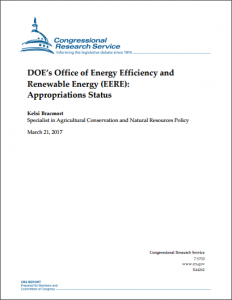Full Title: DOE’s Office of Energy Efficiency and Renewable Energy (EERE): Appropriations Status
Author(s): Kelsi Bracmort
Publisher(s): Congressional Research Service
Publication Date: March 1, 2017
Full Text: Download Resource
Description (excerpt):
The U.S. Department of Energy’s (DOE’s) Office of Energy Efficiency and Renewable Energy (EERE) is the principal government agency responsible for renewable energy technologies and energy efficiency efforts. EERE works with industry, academia, national laboratories, and others to conduct research and development (R&D) and to issue grants to state governments. EERE oversees nearly a dozen technologies and programs—from vehicle technologies to solar energy to advanced manufacturing to weatherization and intergovernmental programs—each with its own respective mission and program goals.
EERE receives funding from the annual energy and water development (E&W) appropriations bill. At issue for the 115th Congress is not only the level of EERE appropriations but also which activities EERE should support, including whether to continue support for specific initiatives and programs. On March 16, 2017, the Trump Administration released a budget blueprint for FY2018. The blueprint states that funding for EERE would focus on “limited, early-stage applied energy research and development activities where the Federal role is stronger.” The blueprint requests $28.0 billion for DOE, a decrease of $1.7 billion, or 5.6%, from the FY2017 annualized continuing resolution level. The blueprint does not specify how much of the proposed $1.7 billion cut would apply to EERE programs. The blueprint specified that the Trump Administration’s request includes two specific program eliminations: the Weatherization Assistance Program and the State Energy Program, which received FY2016 appropriations of $211.6 million and $50.0 million, respectively. The Trump Administration also requested an $18 billion decrease in nondefense appropriations for FY2017; it is not clear how such a cut would apply to EERE.
For FY2017, the Obama Administration requested $2.9 billion of discretionary funding for EERE and $1.3 billion of mandatory funding for a new program, bringing the total FY2017 budget request to $4.2 billion. This total request, if enacted, would be an increase of $2.2 billion (104%) over the enacted FY2016 level of $2.1 billion (the Consolidated Appropriations Act, 2016; P.L. 114-113, Division D). The $2.9 billion of discretionary funding requested would be an increase of $829 million (40%) over the FY2016 enacted level of $2.1 billion. The bulk of the discretionary portion of the request would be split among three areas: nearly 32% for energy efficiency programs, about 21% for renewable energy programs, and about 29% for sustainable transportation programs. The discretionary funding portion of the request is nearly 10% of the $30.2 billion discretionary portion of the FY2017 request for DOE.
